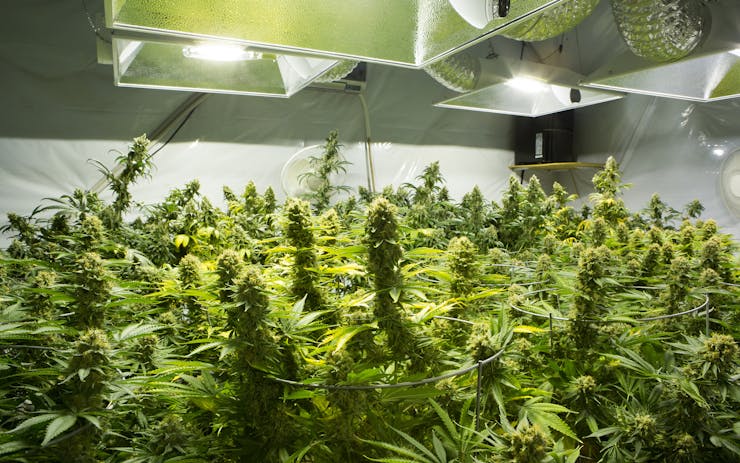Carbon dioxide (CO2) is a gas that fills our atmosphere, and it’s essential for plants to complete the process of photosynthesis wherein plants convert CO2 into energy. High levels of CO2 in a cannabis garden can result in stronger plants with increased yields – if introduced correctly. So how do you control and add CO2 to your cannabis grow room for the best possible end product?
How Does CO2 Work for Plants?

Plants extract CO2 from the atmosphere via the plant’s stomates, which are the pores that plants “breathe” through. Photosynthesis begins as the plant uses CO2 in combination with light bulbs or light from the sun to produce both sugar and oxygen. The sugar is used by the plant to grow while the oxygen is released back into the atmosphere.
Increasing CO2 levels in your cannabis garden will allow your plants to create more energy – if you provide adequate lighting as well. Again, light is the second requirement to create energy for your plants, meaning you must match your CO2 levels with your lighting. However, before we dive into how this is done, there are a number of other considerations to make before investing in a CO2 system.
Who Should Use CO2 Systems for Cannabis?

The benefits of introducing CO2 into a grow space are well known and widely accepted. However, if you’re a novice grower and/or under a tight budget, there might be a number of ways for you to initially increase your yields before investing in a costly CO2 system. Make sure you first know how to:
- Grow a healthy garden with a quality product
- Prevent and/or treat mold and pest infestations
- Set up a secure, sealed grow space
- Use an adequate high-powered light system
- Utilize quality strain genetics
- Use quality nutrients and growing mediums
If you have a handle on the above points, you should be ready to try increasing your yields using added CO2.
How to Introduce Additional CO2 to a Garden

There are multiple ways to introduce CO2 to your garden, but most methods do not guarantee controlled ppm (parts per million, used to measure CO2 levels in atmosphere). For this reason, it’s important to invest in a quality CO2 setup. If the systems below are too costly or demanding for your space, you may consider holding off on CO2 supplemented grows until you’re ready to make the jump.
Shop highly rated dispensaries near you
Showing you dispensaries nearCO2 Generators
CO2 generators, which look something like patio heaters, produce carbon dioxide by burning propane or natural gases. They can be set up to automatically power on or off when CO2 levels reach a specific ppm. Natural gas or liquid propane are very easy to acquire, but the burning of these gases produces heat which can be difficult to regulate in small grow spaces. Because of this, CO2 generators are better suited for large grow spaces with equipment for climate control.
Compressed CO2
Compressed CO2 tanks can be acquired at hydroponic stores, compressed gas facilities, or even home brewing stores. In this case, the CO2 is produced by the manufacturers and is collected and compressed into tanks that can be then made available for purchase. This allows you to introduce controlled quantities of CO2 into your garden via emitters without having to own a CO2 generator. The benefit of this setup is that without a CO2 generator, you’re no longer producing heat when releasing CO2 into your garden. For this reason, compressed CO2 is ideal for smaller grow spaces.
How to Use CO2 in Your Cannabis Garden

CO2 levels in our atmosphere are around 400 ppm. Interestingly, studies show CO2 levels can continually increase plant growth as ppm reach upwards of 10,000. Note that once CO2 is above 3,000 ppm it starts to become dangerous for humans to breathe, and at 5,000 ppm it is considered lethal.
Most gardeners have found that when you are producing high-quality light in your garden, a CO2 level of 1,200 to 2,000 ppm will increase the growth of your plant significantly. Additionally, when using CO2 your plants can handle a higher average temperature – around 85-90 degrees Fahrenheit. Be aware that if your CO2 levels are too high for the amount of light or heat generated in the garden, you will see your plants become damaged from excess CO2.
The CO2 emitted should ideally fall from above the garden, as CO2 is heavy and will sink to the ground. Using fans will help keep the CO2 moving around the room and make it available for more plants to absorb. CO2 should only be emitted during the time that the lights are on; plants photosynthesize while it is dark out.
Growing cannabis is an ever-changing practice. Taking on a challenge such as introducing CO2 could evolve your garden, taking it to the next level. Have you spent any time with CO2 in your garden? Take the opportunity to share your experiences in the comments section below.





